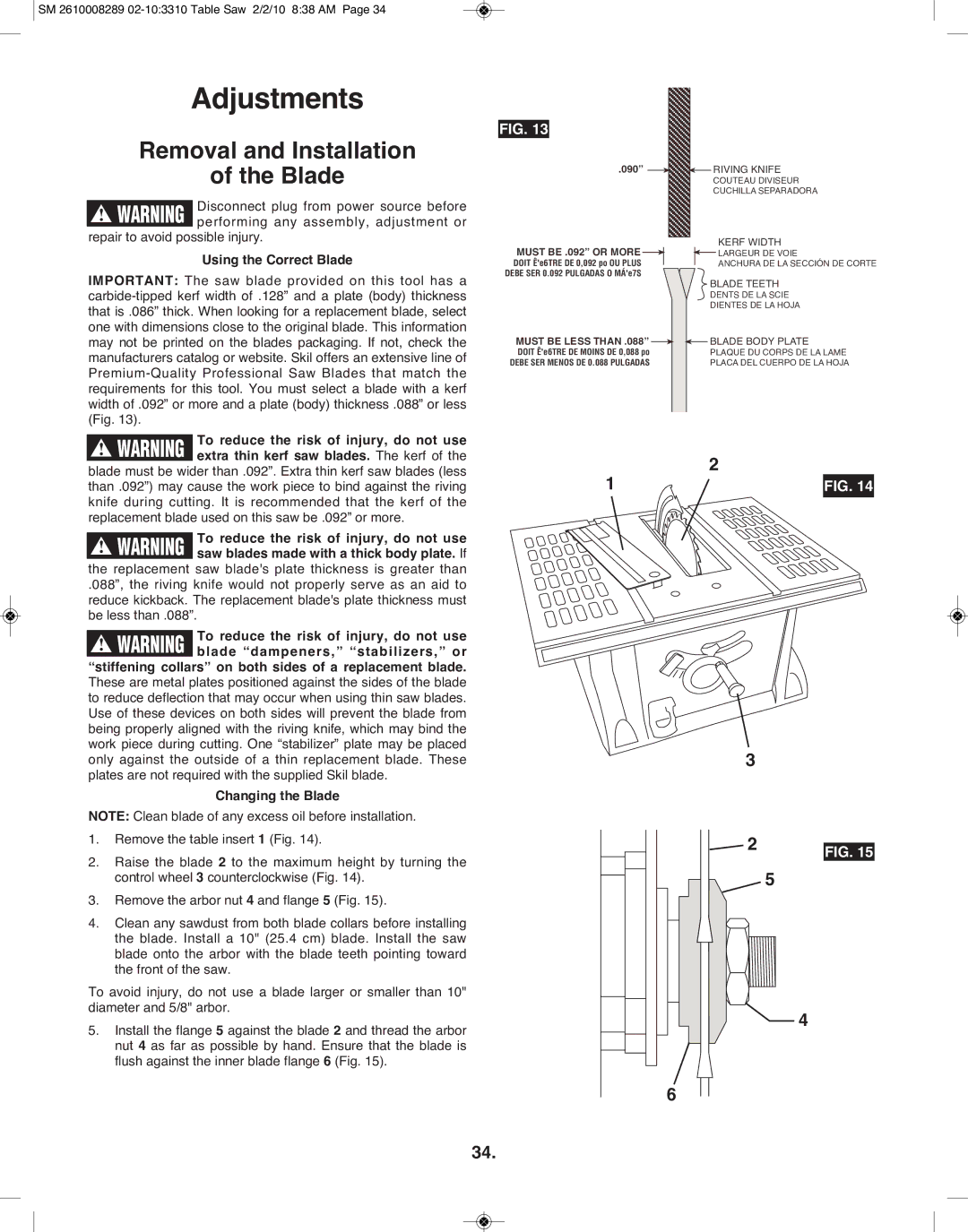
![]() SM 2610008289
SM 2610008289
Adjustments
Removal and Installation
of the Blade
!WARNING performing any assembly, adjustment or repair to avoid possible injury.Disconnect plug from power source before
Using the Correct Blade
IMPORTANT: The saw blade provided on this tool has a
FIG. 13
.090Ó ![]()
MUST BE .092Ó OR MORE 
DOIT Ê'e6TRE DE 0,092 po OU PLUS DEBE SER 0.092 PULGADAS O MÁ'e7S
![]() RIVING KNIFE
RIVING KNIFE
COUTEAU DIVISEUR
CUCHILLA SEPARADORA
KERF WIDTH
![]() LARGEUR DE VOIE
LARGEUR DE VOIE
ANCHURA DE LA SECCIîN DE CORTE
![]() BLADE TEETH
BLADE TEETH
DENTS DE LA SCIE
DIENTES DE LA HOJA
may not be printed on the blades packaging. If not, check the manufacturers catalog or website. Skil offers an extensive line of
To reduce the risk of injury, do not use ! WARNING extra thin kerf saw blades. The kerf of the
blade must be wider than .092”. Extra thin kerf saw blades (less than .092”) may cause the work piece to bind against the riving knife during cutting. It is recommended that the kerf of the replacement blade used on this saw be .092” or more.
To reduce the risk of injury, do not use ! WARNING saw blades made with a thick body plate. If
the replacement saw blade's plate thickness is greater than
.088”, the riving knife would not properly serve as an aid to reduce kickback. The replacement blade's plate thickness must be less than .088”.
To reduce the risk of injury, do not use
!WARNING blade “dampeners,” “stabilizers,” or “stiffening collars” on both sides of a replacement blade. These are metal plates positioned against the sides of the blade to reduce deflection that may occur when using thin saw blades. Use of these devices on both sides will prevent the blade from being properly aligned with the riving knife, which may bind the work piece during cutting. One “stabilizer” plate may be placed only against the outside of a thin replacement blade. These plates are not required with the supplied Skil blade.
Changing the Blade
NOTE: Clean blade of any excess oil before installation.
1.Remove the table insert 1 (Fig. 14).
2.Raise the blade 2 to the maximum height by turning the control wheel 3 counterclockwise (Fig. 14).
3.Remove the arbor nut 4 and flange 5 (Fig. 15).
4.Clean any sawdust from both blade collars before installing the blade. Install a 10" (25.4 cm) blade. Install the saw blade onto the arbor with the blade teeth pointing toward the front of the saw.
To avoid injury, do not use a blade larger or smaller than 10" diameter and 5/8" arbor.
5.Install the flange 5 against the blade 2 and thread the arbor nut 4 as far as possible by hand. Ensure that the blade is flush against the inner blade flange 6 (Fig. 15).
MUST BE LESS THAN .088Ó |
|
|
| BLADE BODY PLATE |
|
| |||
DOIT Ê'e6TRE DE MOINS DE 0,088 po |
|
|
| PLAQUE DU CORPS DE LA LAME |
DEBE SER MENOS DE 0.088 PULGADAS |
|
|
| PLACA DEL CUERPO DE LA HOJA |
2
1 | FIG. 14 |
3
2 | FIG. 15 |
|
5
![]() 4
4
6
34.
